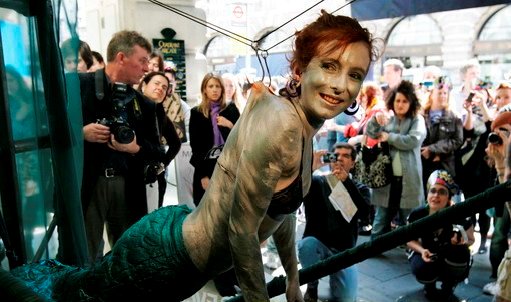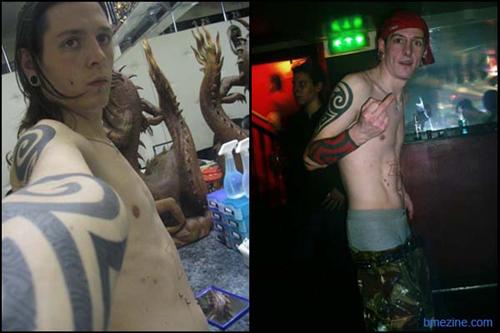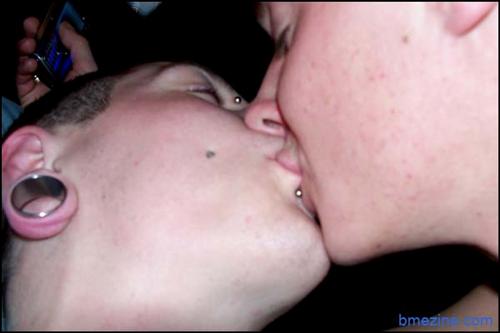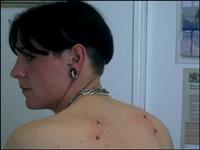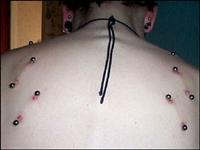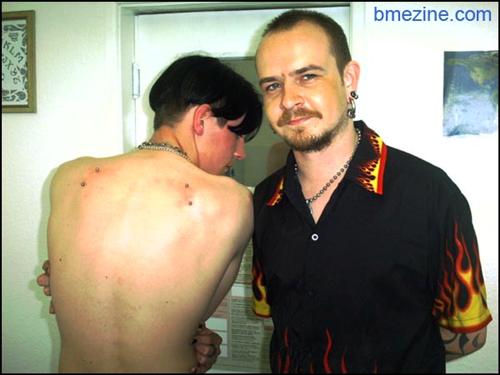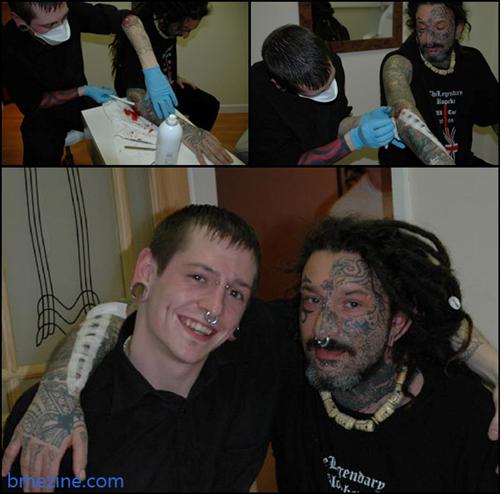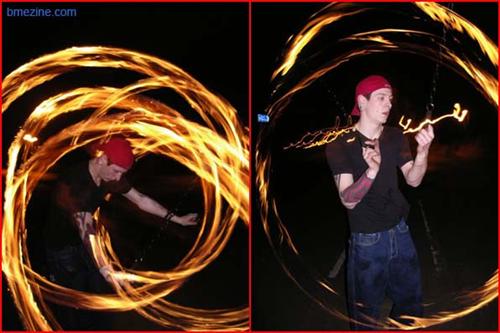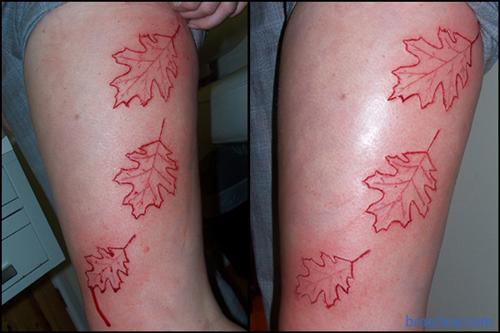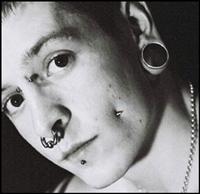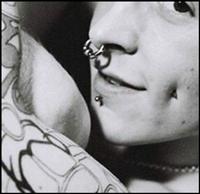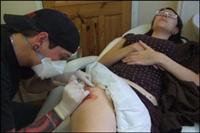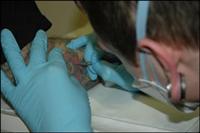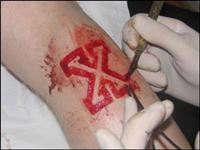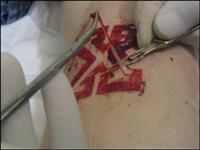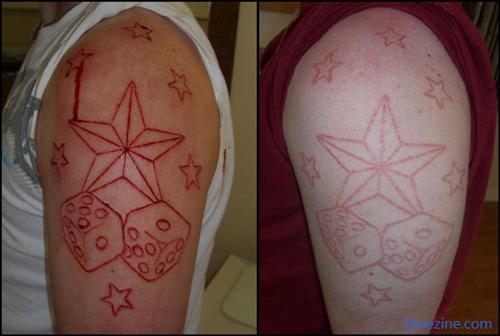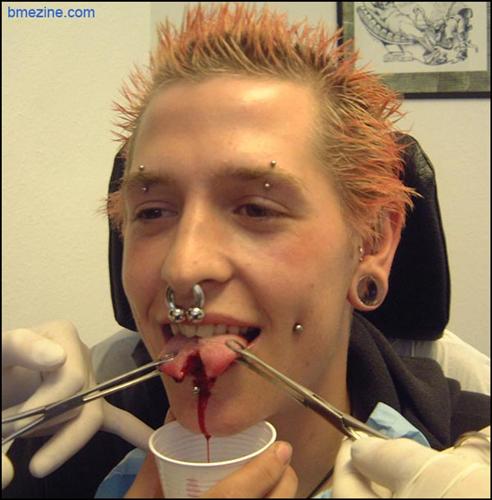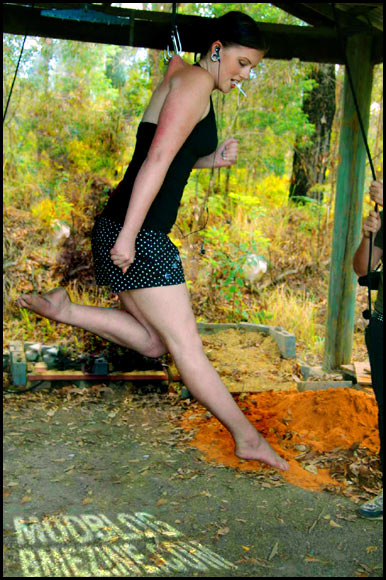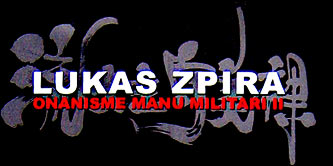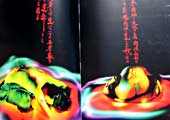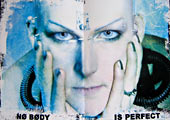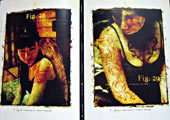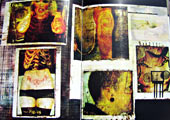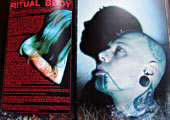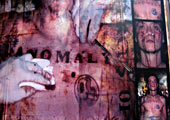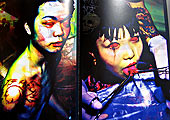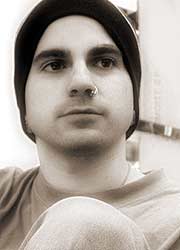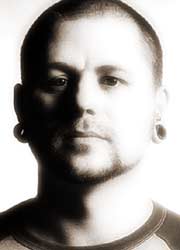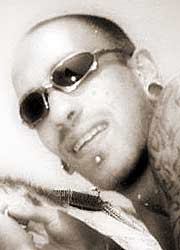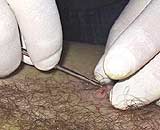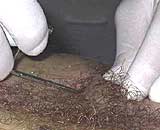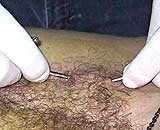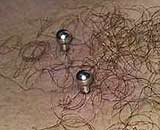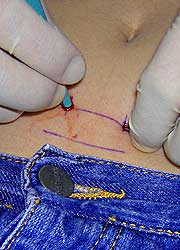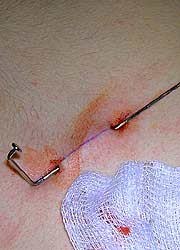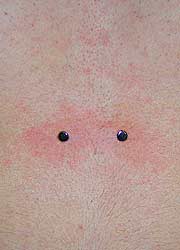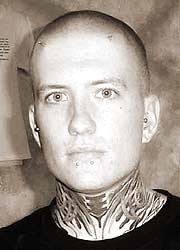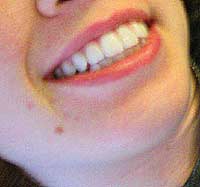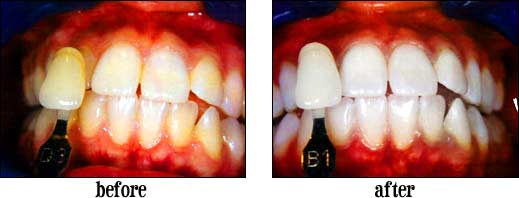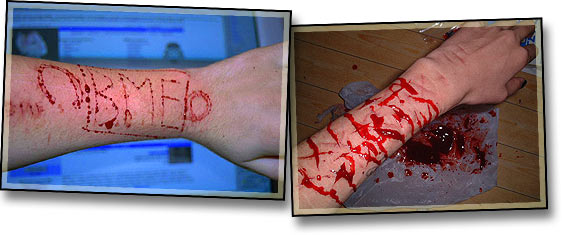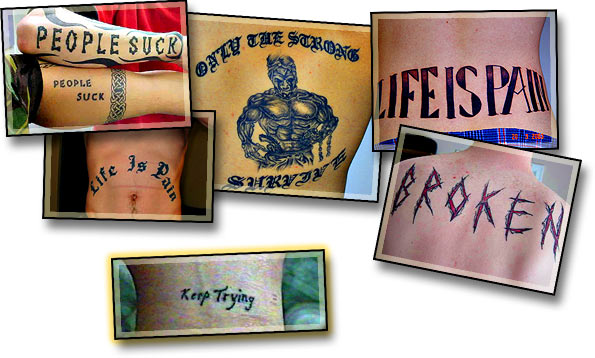Shannon Larratt: Alright welcome back everyone I’m Shannon Larratt you’re tuned into BME Radio we’re here in the brand new BME Radio studio with Blair from Tattorama in Toronto. Also here we’ve got Phil Barbosa one of BME’s resident photographers who’s got extensive work done by Blair and we’ll be talking to him a little later about that. While you’re listening to this you can zip on over to byblair.com to see a little bit of Blair’s work. Although if you’ve been reading BME for a while you’ve certainly seen his piercing, scarification work, implants, and subincisions lots of times before. Blair, as somebody who’s done all of these modifications as well as having dabbled in tattooing, what, what would you consider your title to be?
Blair: Um, you know what? I would just have to say probably just artist.
SL: Just artist?
B: Keep it simple. I think so yeah, because I think I’ve spread myself so much on so many different levels, I think at least I mean doing tattooing and doing scarification, doing branding, doing piercing and doing other different types of modifications. Um, you know I’ve done wood burning, and I’ve built waterfalls and things so to me I don’t see much of a difference in building a waterfall and working on a person it’s just a different art form.
SL: So you’re not even just a body artist, you’re an – artist.
B: Yeah, I think I feel more, more like that now, especially. Maybe a few years ago I might have maybe uh, been a bit more you know picky about what I called myself.
SL: [affirmative noise]
B: Even then, back years ago when we first did stuff for the BME, I couldn’t really classify myself very much. [laugh]
SL: I think tattoo artists especially are real, real adamant you know that you know you pick an art form and you stick to it and you know you get real good at that, you don’t feel that you know you’re spreading yourself too thin, or?
B: You know what, I tell my customers that quite a bit especially when it comes to, um they say that’s all you do is, is you know piercing, you don’t do tattoo and I think honestly if you’re going to be really good at something you should be quite, quite picky about it you should you know focus on one thing. But I think, um you know I’ve mostly focused on body piercing like you know navels and tongues and eyebrows and different genital piercings and stuff but I mean after you’ve done those, those modifications for so long it’s kind of like a base. You know, and the other things start to become more, more like hobbies. And there’s nothing more creative and nothing more, how would you say, at least I think there’s nothing more special than having a hobby that you really care for and I think navel, like the navel piercing and all the eyebrows and all the other kind of stuff that I think 99.9% of the piercers do for a living, it starts to become a little bit like work. You know, you can’t, I mean I must admit I love my job it’s incredible but after a while you know, you must admit it’s a little bit like work. It’s a good work I must admit but it’s not as exciting as like building a new waterfall and having an incredible idea in your brain and actually turning it into something or spending like two or, two hours on drawing the most amazing brand and think like, “Man I’m going to pull this off and it’s gonna look sweet.” So, to me, it’s just art. [laughs]
SL: So is a lot of it taking, you know taking sort of an idea and realizing it? That’s the…
B: Absolutely. Especially with branding, you know. You know you spend a lot of time drawing a branding and especially I think to be a true artist for branding you have to really envision what it’s going to look like you know, three weeks from then you know. And I think that takes a lot of skill to understand how the skin works and what it does when you burn the skin and implant it in such a way, so I think um yeah, I don’t know well…
SL: Yeah, well we’ve got, actually we’ve got some exciting branding stuff coming up from Blair. We’re going to play one song for you then we’ll let you know what the big secret is.
[song]
SL: Alright, now here’s where things get pretty exciting for you. BME and Blair are co-sponsoring a “Best Brand in the World” design contest. The way it works is you come up with a brand that you’d like to have, I mean no limits, no limits at all, it can be as big, or as complicated as you want. The only deal is, you obviously you gotta be 18. But the only real deal is that you have to be willing to actually get it. BME and Blair will pick the best 10 entries and then the actual best one will be flown to Toronto to have the brand done and this is all for free. All you have to do is e-mail a sketch of your idea to BME and in one month we’ll announce the finalists and then a week later the winner. Blair, what made you want to do this contest?
B: [laughs] Um, I just love branding, you know. I love doing big pieces. I mean it’s like um, it’s very much like a canvas, you know you need to have something to work from. You know, if you don’t have something to work from then you don’t have any canvas.
SL: [affirmative noise]
B: I think here in the city I mean there’s lots of people I can work on, there’s no question about it. I mean I have people coming from, flying from all different places and stuff, but I think there’s something special about somebody who really really wants it you know and willing to you know go out of their way a little bit to you know e-mail you, write a little thing about why they want to get branded, um I don’t know it’s very exciting to me. I can just imagine the person being so stoked you know to win this and to fly here and for me to see them in person and talk to them about it and actually see the end result, you know. I just think that’s really cool. Um, yeah, I just wanna do good work, you know, I wanna work on someone and I wanna have fun and I think um, somebody that’s really willing to uh you know go out of their way a little bit I think it would be really fun to work on them.
SL: [affirmative noise] Most people that come to you for branding have you know fairly small and simple ideas, or? What do people normally come for?
B: Um, I try not to really do a lot of work where there’s really a lot of simple ideas. If people, if someone desperately wants to get something quite simple, then, if I have time, then I’ll do it, but I think at this point in time I really try to um, [tsk] I guess you could say push my limits in terms of what people consider a traditional brand. Because I really think a lot of the people that brand out there are just doing really awful work it’s just really simple, it’s really crude, quite basic, and I think um, there’s so much potential out there for doing, you know amazing work, constant lines…
SL: Why do you think that is? Is it difficult to do this type of branding? I mean…
B: I think, even for myself, I’ve been branding for about, I don’t know how many years, maybe four or five years, or longer…
SL: I think longer than that, yeah.
B: Yeah, and I think, I mean, when I first started things were quite simple because you know you’re brand new at it, you know. But just like any other art form you have to progress, you know, you can’t just do the same thing for so long, and I think I’m getting to the point really where I’m almost kind of picking and choosing how I’m going to do a design, um, I shouldn’t say I’m picking and choosing for them but um, if they come to me with a rough idea and I can probably do a very simple rough idea.
SL: [affirmative noise]
B: But I prefer to sit down for a while and actually draw it in such a way that it takes a lot more skill.
SL: So, a person comes to you, we’ll I guess we’ll talk about the one you’re doing coming up here. A guy comes to you, wants an Astro Boy tattoo…
B: Sure.
SL: Gives you an Astro Boy pencil case, says I want it to look like this.
B: Or branding. Sorry, yeah.
SL: What are the steps in taking that pencil case and turning it into a branding?
B: Well, basically what I’ll do, is I’ll look at the design, I’ll think about where the person wants to get it and I’ll think about how big they want it to be. Branding is a lot similar to tattoo where you just can’t do the smallest thing, you know, because if the lines are too close, if they’re too close together they are going to bleed together in terms of like tattoo ink. In terms of branding it’s pretty much the same thing. If the lines are too close they’re going to breed, bleed. So what you have to do is you have to design it in such a way that, that when the whole thing expands you know after the thing’s completely finished then it’s going to expand and in such a way that it’s going to look like you want the end result to be. So…
SL: So kind of like if you’re going to make a complicated design out of cookie dough?
B: Kind of yeah, you really have to think about it ahead of time. Like, when I’m drawing it, I’m looking at it in the future, even though I’m, the drawing looks sometimes nothing even close to what the person wants.
SL: [affirmative noise]
B: Like the barbed wire I showed you today, it’s quite a simple design, but the end result is definitely going to look like bobbed wire, or barbed wire. [laughs] Bob wire. Yeah.
SL: And, then the way that the person treats it, presumably during the healing process makes a great deal of difference as well?
B: Um, sometimes yeah. I think to some degree a lot of it has to do with genetics. You know, either you’re a person who has really good keloid skin, tends to scar quite easily or sometimes you don’t. And I think it doesn’t necessarily have to do with your skin colour. I mean, technically it does. Some people have more melatonin than other people, but I’ve seen white people with amazingly raised keloid skin and I’ve seen black people who raise quite flat. Or not raise at all sometimes. You know.
SL: [affirmative noise]
B: But the one thing that I do guarantee is that um, the width of it and the design is going to look, it’s going to look amazing, whether it keloids and raises or not is something quite different. You know, it’s something that is out of my control and I put into your body’s control. Um, there are some things you can do, like you can pick at it and you can irritate it and you can do numerous things and I think that definitely will increase your chances of getting scar tissue, but doesn’t necessarily mean you’re going to end up with a raised keloid scar but you will have guaranteed a permanent scar and it will be quite visible, it’s something you’ll always be able to see, even if it’s flat. So, I think it’s kind of an old misconception of um you know the guy did really shitty work or something like that because it ended up being quite flat.
SL: [affirmative noise]
B: And I think, no matter who’s going to do the work, if it’s done quite well – on some people it’s always going to end up flat. And I think, um, people just have to, especially branders have to really um, learn to understand uh, you know what, what they can expect from their brand. You know, I think they have to just understand that they can do the full 100% but I think a certain percentage of it is not even up to the person who’s getting it, it’s up to the person’s, you know, genetics.
SL: [affirmative noises]
B: So, and I think once you understand that I think um, you know you just kind of realize that I did my best and that’s all there is to it. The rest is just up to nature.
SL: Right. Now, about, what was it, two years ago? You picked up a cautery-branding unit.
B: Yeah.
SL: And you did a little bit of it. But even for your detailed work you’re still largely doing strike branding. Um, you don’t find that the cautery gives you more freedom and that you can do just as much with strike branding?
B: I think the way that I brand for sure, there’s not much difference. I think um, you know there’s something really nice about holding a paintbrush in your hand. I mean, I’m really, I wouldn’t consider myself a painter at all. I don’t paint much other than you know, the walls of my apartment occasionally, but I, to me, holding my tool is very similar to holding a paintbrush and having to re-dip in the paint again, instead I have to relight, you know reheat the iron up. Um, and I think the way I brand I do like multiple strikes whereas a lot of branders, they’re just, I guess they’re quite new at it, they just kind of hold their breath and go, “Oh my God, one quick shot, that’s it.” And you know, I think that’s just not realistic, so I think, as for the cautery unit it takes a lot of the um, it takes a certain feel away from it you know, it’s like um, it’s like having a paintbrush and painting as opposed to doing it on the computer with Photoshop. I don’t think one’s any better than the other but I think, um for me there’s a certain, I can’t explain it. There’s a nice feel to it, I always, for years I’ve always considered branding very much like painting.
SL: [affirmative noise]
B: You know, I hold that thing in my hand and it’s just like these nice brush strokes you know, it’s kind of like that.
SL: Well I think overall you, you know, you’ve made similar decisions before like, you know you drove a motorcycle rather than a car.
B: Yeah, little skateboard [laugh] instead of a anything else [laugh]. Yeah.
SL: Um, we’re going to play another song and when we come back we’ll talk about some of Blair’s traveling in Borneo and Mexico and collecting of a variety of indigenous jewellery.
[song]
SL: Alright, Blair you just got back from your second trip to Mexico now that was more of a recreational trip than a body oriented trip. What were you doing down there?
B: [laugh] Well basically I wanted to tour a little bit through Mexico and um, and see some of the Mayan temples I also wanted to see Mexico city cause largest city in the world. I love chaos, you know I love big big cities, it’s amazing how they function you know, it’s incredible.
SL: Are there studios down there?
B: I saw a few studios down there.
SL: What were they like?
B: Their standards are a lot different.
SL: Yeah.
B: Definitely a lot lower. I mean I shouldn’t really say that but, the shops I saw, the standards were quite low. That’s all I’m going to say, it’s just a different way of thinking you know.
SL: But mostly you were surfin’.
B: Mostly I was surfing, yeah. That was the thing. Yeah, I met some amazing people down there and I surfed. You know I have to say one thing, I saw this tattoo shop down there that just scared me. I was visiting, I had a card on me and I thought, oh wow how’s it going you know, can I have one of your cards? He was tattooing this guy he pretty much just opened the counter door with his bloody gloves, grabbed the business card and dropped it in my hand and I just picked it up with my fingers and just dropped my card and thought oh my god these people, I felt so bad that so many people are being cross contaminated potentially. And not even knowing anything about it. That’s what I mean. Standards are a lot lower, that would be completely unacceptable in Canada. I’m sure it’s unacceptable anywhere.
SL: [affirmative noise]
B: Anyways, surfing is good! [laughs]
SL: [laughs]
Phillip Barbosa: [laughs]
SL: You’re just as recreational but more oriented to this trip. You recently got back from Borneo.
B: Right, yeah. It was amazing.
SL: Now, you went over with Erica Skadsen of Organic and a number of other people.
B: Yeah, it was amazing, you know. I went to um, to Borneo and I stayed with the Iban tribe and the Kayan tribe.
SL: How, how do you get there?
B: I was lucky enough to meet Erica a few years ago, you know ordering jewellery from her. She’s such an amazing person. She invited me to go and I gladly went. I’ve always wanted to go you know into the jungle and you know Borneo, I remember liking Borneo since I was a kid and just the thought of going there was pretty exciting. I mean, in order to get to the jungle you know what it’s, I think I was quite lucky. I think when I went with Erica I learned a lot about how to travel in those kind of um, how would you say, I don’t know in that kind of situation you know like not speaking the language, learning how to catch boats, learning how to…
SL: Okay so what happens, you I mean I assume there’s a major airport somewhere in Borneo, or nearby?
B: Yup, uh, yeah there’s a major, one major, I’m sure there’s probably a few, I’m sure there’s one in maybe uh Brunei, and there’s probably one in um, Indonesia.
SL: So you land there then you catch a long boat up the river or what happens?
B: Well, what we did was we ended up um, we flew into there, it took like, I think all together we spent about for me I think it was thirty something hours maybe thirty-four hours traveling getting to where we were going and basically we flew into Kuching City and then from there I think it was a twelve hour bus ride and then from there it was like a five hour river boat ride and um, it was amazing.
SL: When you show up at tribal longhouses are you a tourist, I mean what do they think of you?
B: I think um, because my ears are stretched, and because I’m tattooed and because I think those people don’t really see that many white folks you know I think there are tourists and that, that go up there, but I think that some of the places that I went to I don’t think they saw you know tourists and it’s such a long long time so I think it probably happens maybe you know maybe a few times a year. There was one longhouse we stayed at and it was, it was in kind of more closer to a major town four hours away from the other longhouse that I went to and they had like a little guest book and I think lots of tourists went there for sure. But I think um…
SL: But not many of them would actually stay there?
B: Most of them I think wouldn’t stay there.
SL: I mean it’s not like a longhouse takes visa right?
B: No, nothing like, it’s a bit different than that. [laughs]
SL: [laughs] But when you stay there how do you eat, where do you sleep?
B: Well I’m vegan so it was really hard, I had to bring so many vitamins and anytime I found something like you know any kind of nuts or anything I made sure I grabbed them. You know, where we went to we were pretty welcomed because, I think Erica was corresponding with one of them for such a long time you know with letters and stuff and man, they don’t get half of their mail, so it’s a hit and miss whether they’re going to receive it or not. I’ve sent packages and stuff there and I know they haven’t received it. Um, but uh, they, we made kind of rough arrangements that we’d show up around this time and uh, we went there and we were just welcomed immediately and I think it really helped that we were tattooed and pierced and I think, I can’t explain it, I just kind of fit right in there. I mean the life there is completely different, I found that a lot easier to adjust to.
SL: Are they living like a picture book tribal life, or what’s it like?
B: Um well there’s no telephones…there’s no hot water.
SL: What do they spend an average day doing?
B: You know they make things like mats and they do, they make um I mean they farm in the paddy fields, they go into the jungle and they hunt for um, pig – babi, and they um. Man, they do a lot of hunting um, they you know they fish in the rivers and stuff. Sometimes they use this poison root you know, and um it helps the, it’s hard to explain, I think what it does is it deoxygenates the water so the fish get intoxicated and they start floating up and you have to get them with spears and you have to get them with nets. So they’re always busy mostly getting food.
SL: [affirmative noise]
B: That’s the main thing. Without food you don’t really have very much. I think a lot of the men end up working in logging camps and possibly in oilrigs and stuff. And all the older men and all the children stay at home.
SL: Right.
B: Well, I stayed at like a I think all together, I stayed in f…six different villages. Some was for like five days some was like for two days some was for, I think the longest might have been for seven days in one place. And they were all in different parts. And some places were probably close to like, maybe sixteen hours away from anywhere.
SL: [affirmative noise]
B: You know, if you needed a hospital you’d be pretty far to get to that, that’s for sure. Uh, and other places, were not that far off because the, a lot of the Iban and the Kayan and Punan and all the other tribes, they’re all living all around the whole island, you know so some are close to cities and some are extremely far away. So, yeah, it was good. I can’t explain it. It was so, there was so much.
[telephone ringing]
B: [laughs]
SL: Well, that’s annoying, uh we’ve got a phone ringing in the background that we’ll just ignore, we’ll let Phil pick it up and tell them to call back later.
B: Yeah, I mean there was so much to know and there was so much that I learned, and I wouldn’t really want to be giving people directions on how to get there because I think that would probably be the worst thing for these people. So, but it was a good adventure and it was really, uh, really quite a trek through the jungle. It was good, I mean the coolest thing I did, I think was, was fishing in the river using that root you know, I didn’t even eat the fish because I’m vegan but these people are giving you everything. They’re giving you sleep, they’re giving you food, you know they’re giving you everything so the least I could do was at least you know catch food for them. Very minimal.
SL: [affirmative noise]
B: Um, it was good. A good experience.
SL: And then right after that you did about the exact opposite and headed over to Japan.
B: Yeah, that was a, that’s where I had culture shock. Because I’d been in the jungle for, by that point, I think close to I think maybe sixteen days, was the longest time I think I spent in there and to go from that I went to um, a friend of a friends place and they were quite rich. And with a maid and everything and I was in complete culture shock, I didn’t know what to do. I was like I was afraid to like mess up the bathroom [laugh]. I mean, from living, from living in the interior and going to the washroom anywhere you please or in like um little squats where you have to, you know you get the bucket of water to flush it down into the river. Going from that to like every faucet was finely polished and the maid would make absolutely anything you wanted, I felt so much closer to the maid than I did to the people I was staying with [laugh]. It was good.
SL: [laugh]
B: But it was a big culture shock.
SL: Alright, we’re gonna play a little more music. I’m going to figure out what that phone call was and when we get back we’ll talk about subincisions and implants and if you thought the scarification was scary now’s when you should hit stop on your Real Audio Player and if not you’re gonna find out some stuff you didn’t know.
[song]
SL: Alright, well that goes on for a long long time so we’re gonna, we’re gonna break back into talking. So Blair, one of the more hardcore and maybe even controversial pieces of work that you do is subincision. What exactly is that?
B: Well, basically subincision is when you, you basically cut the urethra open so that it’s exposed and then you…
SL: Hold on a sec, we’ve actually, we’ve got Phil here, and you’ve actually done one on Phil. I’ll direct this question to you, why in the world would someone want to do such a thing?
PB: Well for me it was always just something interest me the aesthetic of it, for one, it adds girth, like visually, it just, the whole esthetic idea of a subincision appealed to me and that’s why I did it and after seeing Jay interview Jay subincision, I think it was on BME that always interested me, like just from looking at it, it looked like the neatest thing and the idea of being able to adorn it differently by piercing it down the sides of the ridges, and the idea of having a whole other surface that’s sensitive all of a sudden. Where before you just had the base of the shaft of your penis and for most people it’s rather callous and numb and all of a sudden you cut it open and it’s brand new sensations in a totally different world, when it comes to your sexual sensations or anything.
SL: Now, you know, the, I don’t want to embarrass your girlfriend too much but uh, just a little [laugh] does it work? I mean, it’s healed now are you happy with the results?
PB: I’m happy, um, from what I understand she’s happy. She didn’t have any real problems with it. She was actually there for the procedure. Funny little story, she was there before she was, she came with me just as a friend, and sat through the whole procedure, documented the whole procedure and weeks later we started dating, we finally did actually um, have sex it was a different experience. I mean, it wasn’t totally different than anything else she’s ever experienced. I mean, I have multiple genital piercings so that was different enough but um, I think just the, things like oral sex were different and from what I gathered, I was told everything was different yet at the same time strangely more comfortable.
SL: [affirmative noise] I think one of the things that Jay has always said is you know from a philosophical point of view one of the things a subincision does, is, because you urinate out of the base now it makes the penis nothing but a sexual organ. Uh, you know it loses all functional purpose other than that. Um, Blair, how would you, sort of in comparison to your regular clients, how would you characterize, who comes to you for a subincision?
B: Um, wow, that’s a tough one. You know, I’m really picky about who I work on and I think, you know because it’s a subincision, it’s such an extreme procedure I think that, I mean the people that I’ve worked on really are people who’ve pretty much tried to do it themselves you know. I consider myself somewhat like a facilitator you know I’m not sure if I would do a subincision on absolutely anybody. You know people have to understand the implications when they get a procedure like this it’s permanent I mean I’m sure you could probably go to a plastic surgeon and get it refixed.
SL: You can but it’s a mess afterwards.
B: Yeah, I mean you pretty much have to think that like it’s a permanent procedure the people that I’ve worked on pretty much of other tried to do it themselves were still absolutely convinced that this is what they were wanted that they were willing to you know make it you know a permanent a permanent you know thing. So, um, I mean I’ve, I’ve, man, the people I’ve worked on are so different like you know from photographers to computer um…
SL: And a real age range too, I mean Phil you’re what, twenty-two, yeah and…
B: Yeah, I think two people I worked on were twenty two be other two were like fifty and fifty-five or something and I think it, you know, I’ve had I can’t even like really characterize them because they’re all completely different it’s just like tattooing and it’s just like piercing and it’s just like everything else I’ve done there’s just such a wide range of people you can’t really. I mean one person was into fetish, and one person was not at all into fetish you know I mean you can’t really.
SL: Did fetish work it’s way into the procedure or?
B: Oh, absolutely not.
SL: And, I mean in his head, even if you actually didn’t do anything.
B: Uh, ooo, I don’t know that’d have to be his head, I don’t know. [laughs]
SL: Maybe you don’t want to know the answer to that one. [laughs]
B: No, I mean I try to I consider myself much like a facilitator in I draw lines on what I can what I will work on I think even you know Shannon that I’m probably a bit more conservative than a lot of people what you call cutters or something but I have limits I really prefer to work on body modifications that were traditionally done by the lay person. You know, subincision was traditionally done by aboriginals in Australia, pearling was traditionally done in Japan and all over Asia I’m told also in parts of Africa, um I mean there’s so many different types of body modifications out there but I really prefer to stick to those you know. But I tend to change it in such a way that it becomes very, like I’m very picky about procedures you know because you have to be very picky about cross contamination and sterilization and all that kind of stuff so.
SL: I’m assuming a subincision especially because you’re really opening the body up and there’s a lot of blood and…
B: Yeah, absolutely but it’s the same thing as doing a cutting on somebody’s arm or on their leg you have to be very meticulous about, you know not cross contaminating, or not infecting them or infecting your shop for that matter you know. So you have to be very picky about that so I kind of take what I see as being traditional body modifications and taking the modern tools and the modern techniques that we have and using it you know to its advantage you know. But I think there’s a limit you know people have called me wanting the utmost extreme different types of body modifications and I know from what I believe you know from human anatomy that there are limits you know and as much as to see people on the BME with pretty extreme different body modifications as an artist I feel there are limits and I think I have safe limits.
SL: [affirmative noise]
B: And I think if people you know if I don’t feel it’s very safe and I don’t feel that they are suited to such a procedure I gladly turn them down I’ve had no problems with that at all. And I think, um it is a kind of weird procedure you know because it’s something that technically a physician can’t do I mean. Well I shouldn’t say technically a physician can’t do but I mean a physician’s not licensed to do a subincision. So I think for me being a lay-person.
SL: I think doctors, yeah they’re very restricted in the type of procedure they do.
B: Exactly. So I think I have to be very picky on who I’m going to work on you know.
SL: [affirmative noise] Now, you know, I don’t know, which is trickier but you’re also, you’ve also done a lot of genital implant work.
B: [affirmative noise]
SL: Um, now you’re tools have sort of evolved over time, your procedure has changed. You want to talk about what you were doing first and then how it sort of changed into the way it is now? You know scalpel versus needle and…
B: Yeah, I think I mean when I used to do pearling I used to use, traditional needle and stretch and taper and now it’s worked ‘til like scalpel. And now it’s worked to, and you know different tools for a basically creating pocketing and um it’s still something that’s still new for me and I still have to learn to work with these crazy tools with my friend Phil over here. [laugh] But I think, um yeah it’s evolved, I mean everything has to evolve. I think when you find something you when find a new technique and I think because you’re working on a human being that you have to learn to make things better you have to learn to make things safer, you have to make things more efficient it’s not like you know carving wood, you kinda if you’re happy with it you stick with your old methods. I think…
SL: The first time, or the first couple times are inherently you know they’re experiments, I mean, you know you can do as much research but I mean, Phil, how do you, how do you feel about knowing that you know this procedure that’s being done on you, it’s the first time it’s been done and you know, who really knows how it’s going to turn out and…
PB: I don’t know, I getting worked on by Blair for so many years, I just know that, I mean he’s a solid practitioner I guess or artist if I can call him that, like just procedure wise, bedside manner everything, and he knows his stuff it’s not something I’m concerned about that it’s you know I’m going to walk away being all mutilated or anything like that. Like obviously if he has a doubt in his mind as far as the procedure goes or the way this is going to be done it’s just not gonna happen. I’m, over the years of getting worked on I’m more than happy to put my trust into Blair’s hands as are most of his other clients I mean I’ve met other people that Blair’s done work on and they won’t let anybody else touch them, like piercing anything.
SL: Well, I think Blair’s know that if he needs to make a judgment call on a procedure he’s usually makes the judgment call on the conservative side.
B: Quite conservative side. [laugh] Yeah absolutely.
SL: I mean, even though, even though I think people look at these procedures and really think they’re far out you know, weird stuff they’re actually still on the safer side of you know what people try.
B: Absolutely, I mean you can just imagine what it would have been like you know a hundred years ago doing a subincision in Australia. I mean can you imagine. I just I mean the, it must have been quite crude you know.
PB: All they had is a sharp rock.
B: Yeah.
SL: I think that’s important to point out too, that all these procedures have, you know they’ve been done basically by field medics. You know.
B: Absolutely.
SL: You know, with a real minimum of precautions that we have access to.
B: Yeah. I don’t doubt that they really, they knew which herbs to use for this and which herbs to use for that but I mean the standards were quite different you know and I also think they’re immune systems were probably quite, uh, they’d probably be a lot more immune to bacterial infections because they were living so close to the earth. Where we’re living in a quite sterile environment.
SL: And I think, I think they probably had less bacteria to deal with they don’t have, you know, the super bacteria that we’ve you know, evolved in the west through constant use of antibiotics.
B: Yes, absolutely.
PB: I think they do it the same way so many times over and over that they’ve just understood a very specific way of doing it. I’ve read that the Australian, the way they used to do it was basically with a sharp rock and some thorns to hold you together but from years of doing it over over an over you know, and passing it on to lay people obviously they understood that this is exactly how it’s done and it’s done the same way over and over and over and it’s just refined over the years.
SL: [affirmative noise]
B: [affirmative noise] Yup, I mean I had one client who was, he was HIV positive and my biggest concern with him was that my procedure was going to be the one thing that’s going to send him you know, over the edge. So, I um I sent him to a physician so he could get his um, viral loads and his um, and just basically see if everything’s alright with him and then the physician actually called me up in person and said that everything was fine with him in terms of his health and he’s willing, he felt that he’d be okay to do this procedure.
SL: This was a, what was the procedure?
B: This was a subincision.
SL: [affirmative noise]
B: Yeah. So, I mean, I had that concern…
SL: What was his motivation in doing it do you know?
B: You know, I think, I think he really had wanted it most of his life, and you know even before the BME site some of these people at least the two older people that I’d worked on had thought of this for close to twenty years. And I find that quite astounding and they never even knew of the aboriginals even doing this. In fact both of them, I gave them photocopies of this aboriginal of um, who had a subincision because they’d never saw it before, and and I think one guy had wanted it for so long and I guess he did find out he was HIV positive and he felt that at least before he goes he at least wants this.
SL: [affirmative noise]
B: So, I was, you know, glad to oblige him for sure.
SL: [affirmative noise]
B: Providing everything was safe. That was my biggest concern of course.
SL: Now Blair, you’re not actually subincised yourself but, I mean you’re covered head to toe in a variety of modifications and when we come back we’ll ask you a bit about those.
[song]
SL: Alright, Blair, I’m looking at you and I’m seeing you’ve got your face tattooed you’ve got you know huge stretched ears, you’ve got uh tattoos on your hands you’ve got brandings on your forearms and I’m sure all sorts of stuff that I can’t see under your clothes.
B: Cutting on my stomach. Yeah.
SL: What, what are you trying to achieve with the changes you’ve made to your own body?
B: I think when I first started to get tattooed it was kind of like a like venting almost you know. I had a lot of troubles when I was a kid and a lot of um…
SL: How old are you now? I mean we look at magazine articles…
B: Today I’m twenty-five.
SL: It’s a different age every time.
B: Today I am twenty-five. [laugh]
SL: So you’re ageless. Alright so you’re having trouble as a kid and sort of expressing that through tattooing.
B: It’s amazing, it’s and amazing I mean to physically put on your body permanently I think is incredible you know. I think it has a certain symbolic meaning that you can’t really do anywhere else. I mean you can’t, you can paint on a canvas, but it’s never quite the same as when you actually put it on your body. So that’s how I basically got started. And I think you know I got into piercing and I found that so incredible and it really taught me a lot about myself and a lot about you know healing in general you know. But I think now I’ve changed so much I’ve grown so much, and also from working in the industry for so long I think really I look at it like, one big canvas. And I don’t now, when I get a tattoo, I don’t really think about the whole meaning and the whole symbolic you know meaning behind all of that because I think I got my shit together, I know exactly who I am, I know exactly what I want, in life and I know that I don’t necessarily need to put it on my body you know basically I’d like to look at myself when I’m finished and see one big work of art you know, I want to see the bottom half of my tattoo, like from my waist down, I wanna see it like one simple tattoo and I wanna see the top half one simple tattoo. So basically I’ll have two tattoos in my body with exception of my chin and um, my hands are I guess a little bit different than the rest. They’re like, um, I guess, what are they? Little patterns.
SL: We’ll get Phil to snap some photos too.
B: Yeah. But that’s basically how I feel and a lot of the spiritual stuff that meant so much to me still do but they’re basically being covered over just for art.
SL: You’re back piece is a tree of life, is that, is there spiritual meaning there or is it more of an esthetic statement?
B: Well I would say it’s definitely a spiritual statement but it’s so esthetically pleasing, you know it’s like a Tibetan style tree with Tibetan mountains and water and I don’t know, it’s just beautiful to me. There’s nothing, I guess, what I really wanted on my back was like a little vision of paradise.
SL: [affirmative noise]
B: Life’s a bit crazy you know, as much as I like the chaos, there’s nothing nicer than simplicity and nothing is as nice as nature.
SL: Is that why you’re starting this new business, building waterfalls?
B: Yeah, it’s just a hobby. You know, I really like, I mean waterfalls is such an amazing medium. You know you think of a frame that you’re going to build out of concrete or stone, or out of whatever you choose to make it out of, and then you basically build from then on up. You know, what you want the structure to be, where the water is going to come from and you can kind of bend it and manipulate it in such a way that aesthetically looks pleasing but I guess more importantly it’s got to sound right. You know, so you put that all together in one big package and it’s just it’s incredible. I’m not, I don’t really have a lot of time to do artwork all that much but when I do, I tend to get completely consumed in it so if I start a project like a waterfall I pretty much go straight to the shop, I pierce, I work on everybody, I leave, I go straight home and I just get obsessed with my project until two weeks later, three weeks later it’s completely finished and it’s like, “Whooah.” What an amazing job. And I look at it and I’m just glowing, you know. And then, I don’t know, that’s it. It’s cool. Maybe that’s what art should be about.
SL: [affirmative noise] Now, let me ask you, you’re brandings that are on your forearms and the scarification that is on your stomach. Was that a venting process or why did you get those or was that sort of just learning to brand and…practicing?
B: Um, I think it was a bit of both you know. I don’t really feel like I actually had to try to learn much of anything. I’m lucky I guess, because it all just completely fell into place. You know, there was a time in my life and I’m sure a lot of people can relate to this and you feel really aggressive towards yourself and you really feel almost in a negative way you would like to either cut yourself or burn yourself or damage yourself and I really felt that, that was such a shame such a cruel. I mean, it’s such a negative energy, why would you want to inflict that on your body and permanently wear that? And I think…
SL: You must have clients coming to you occasionally that…
B: No, not at all.
SL: No?
B: No, because I think if a person is going to, if a person is going to do something negative towards their body they’re going to do it themselves.
SL: Right.
B: They’re not going to go to a professional and we’re going to sit and talk about this and how you would like the design, they’re not going to sit and do all that stuff so, just so that I can damage them you know, it’s, and I think for me it’s such a shame that I was thinking in such a way that I needed, I still needed to vent in that way but I needed to turn it into art. And I think the energies is so completely different and it’s like creating something positive on your body and venting that energy as opposed to creating something negative on your body and you know having to wear that the rest of your life and having to think oh man, I mean I’ve done, I’ve branded people who I had to fix up what they’ve damaged or cover up what they’ve damaged. One person in particular had you know hack marks all over his arm and they were quite, quite large and it was so visible and they were done in such a way that you just knew, you could just look at a person, you could tell you know they had a tough life.
SL: [affirmative noise]
B: But he wanted to cover this up and we designed a little um, a little branding, well I guess not that little, I guess it was a half sleeve.
SL: Almost like a Kandinsky design.
B: Yeah, it was very kind of abstract you know.
SL: Yeah.
B: But it was done in such a way that it turned his negative energy into something positive, it turned it into art. And I think he’s quite happy with it.
SL: So there you weren’t just an artist you were a bit of a healer in that as well.
B: Yeah, I think in some ways. I mean, I think in my work sometimes I’m a bit of a healer anyways because I’ve met customers who really need to learn how to meditate and I had time. And it was like, “Oh god if I’m fifteen minutes late it ain’t gonna kill me.”
SL: [affirmative noise]
B: And I basically sit with them and talk with them about meditation and teach them how to do meditation. It’s not necessarily a religious thing at all, it’s about learning how to get your own shit together in whatever way you find is suitable but it’s basically about getting your shit together and there’s something nice about working with people and um, you know getting to have small opportunities, little smidgens of you know helping people here and there. You know, I’m not sure how long we have but, a friend of mine told me something and he said, “There’s nothing more exceptional than a person who can work with people.” And he said that, “It’s one of the hardest jobs you can do regardless if you do, if you’re a physician, whether you work with acupuncture, whether you work with hair, or whether you do you know body modifications and stuff. It’s quite a stressful job and it’s quite a hard job you know working on that kind of level with people especially when it’s something very permanent. But it, there’s also something you can grow in such a way and you can grow on such a level that I think most people would find extremely hard to do if you are working in a factory somewhere.
SL: [affirmative noise]
B: You know. And I think, I think it’s helped me a lot. I’m sure I’m always going to work with people. You know, whether, and I think also, I’m not sure if I’ll actually be a tattoo artist or if I’ll actually be, you know I don’t think I’ll be a tattoo artist. I’ve done hand poked tattoos on close friends but, I’m not sure I’ll actually be a piercer or what I’ll be doing in the future. But um, you know, life keeps on changing and I think maybe in the future I might do some healing work. Possibly. I don’t really want to stick myself to one specific career, because I don’t think that’s very healthy.
SL: [affirmative noise]
B: I think just because you’re a piercer now doesn’t necessarily mean you’ll always be a piercer. And I think to make yourself so headstrong is just, it’s very, it’s just limiting yourself and I don’t really want to limit myself.
SL: Well like piercing on it’s own is inherently a pretty limited field. I mean you can only go so far with it.
B: You can only go so far, and you have to do something else. Absolutely.
SL: [affirmative noise] Or you, or you do, or what happens is, as has happened to a lot of the really great piercers who’ve been around a while you get to hate piercing.
B: You get to burn out. You hate piercing you burn out, and you just have to find ways to keep things moving, keep things changing. And you know change your perspective and stuff, and I just think it’s really important, that you know people shouldn’t just stick to doing, stick to doing what they’re doing I mean you always need the option of changing.
SL: You keep growing and learning, I mean you’ve been taking, what is it trumpet classes and dancin’.
B: Absolutely. [laugh] Photography, and surfing, what else have I done, my god, I don’t know. I’ve done so much. I took hang gliding once and I got my scuba diving license and I studied carnivorous plants and horticulture and I don’t know, karate [laugh]. That’s all my life.
SL: Now I don’t know if this an embarrassing question but I mean, the brands that you’ve got and the cuttings on your stomach, I mean they prove that you can, you can you know handle a great deal of, a great deal of discomfort.
B: Absolutely.
SL: But you’ve been getting tattooed under anesthetic. Um…why, why is that? Why, you know?
B: Yeah. Do you want to know why? Because I think, I think I’m not sure, but I think because of being vegan and I think also I’ve been tattooing my body and branding myself and piercing myself and pushing my limits so far for so long and on a physical level that I think it’s really hard on my system to get tattooed you know. Like for example, you know when you get tattooed, it hurts, your liver constricts because your body’s under stress and all your organs end up you know paying for it so you end up feeling you know quite irritable. And I think back when I was I think 20 years old, not that I’m that old [laugh] now back when I was 20 years old it was great, it was all a completely new experience to me. But I’ve been tattooing my legs almost solid black for such a long time doing this design that we’re working on that I, it’s just very difficult that I leave the place feeling like I got hit by a Mac truck you know and I’m just completely exhausted and to do all that and to be able to work on all my customers and to give them my attention or at least give them the attention that I think they would deserve it’s really hard to do that and get tattooed once a week. It’s just it’s impossible.
SL: [affirmative noise]
B: And I think I’m not really concerned about being such a macho guy or such a man really I just wanna, I just wanna have nice work on my body. There’s definitely enough pain involved with healing it you know, and I’m really looking forward to doing another suspension hanging in the future. So, I think um, there comes a time and a place in life where you have to find a balance you know and I think my balance is, you know I’m planning on being completely tattooed, I know it’s probably going to take some time off of my life.
SL: What, I mean, what, I mean for the last, I’m not going to say for how many years but for the last number of years you know it’s been a constant constant process of body change for you.
B: Absolutely.
SL: Things always evolving, always evolving. What’s going to happen when that stops? I mean when your body is filled up, when you’ve got it where you want it, you know, and you’ve still got another sixty years to live?
B: Oh, it’s okay. [laugh] You know what, I swore I was not going to be tattooed after I’m thirty-five, because I really, I really want to get all my work done early. You know.
SL: Then you can get onto other things.
B: Then I can get onto other things, I can enjoy my life. I mean there is always going to be touchups. Like I said there’s always going to be suspension hangings. It’s such a spiritual, it’s such a spiritual and emotionally growing thing that I could never not do that. I mean, I don’t care how intense the pain is. It’s so worth it. You know, so that will always happen and um, I mean piercing is great, you can always take it out.
SL: What do you get, what do you get out of a suspension? What was that experience like?
B: Man, I learned a lot about myself and I learned a lot about people and I learned a lot about psychic energy and how and how it works and you know like, for example you know when you do a suspension hanging you are either going to take it as what I believe is being two different ways. You’re either going to accept it and become more physically in your body because you’re physically hanging and you can feel it there’s no doubt about it you can feel it. So you either become either more physically attached to your body or you can leave your body if you choose not to like it or if for some reason you find it difficult you can leave your body you know. For me I felt very, it was very easy to do a suspension I was so clear, my mind was so clear, and I pretty much knew what it was going to feel like, way in advance. It was almost like something I had done already, but after I did that I found I was so, so in my body that I could really feel everyone’s energy so clearly I could feel all the different issues and all their different problems and I could feel, I could feel the walls around me you know, it was quite, quite a difficult experience.
SL: [affirmative noise]
B: It was very difficult.
SL: Almost, almost like it opened you up.
B: It opened me up on such a huge level, and that’s such a good experience. I mean it was painful and it was difficult but I learned so much from it and I think um, I just can’t wait to do the next one. I can’t even imagine how it’s going to change me. You know it changed me so much doing the suspension, I was quite afraid of many things after you know I was afraid of other people’s energy you know being some people are so crude and so blah, so forceful you know I found it very difficult to separate myself between that. That’s also something I learned a lot in Borneo. I learned a lot about myself and I learned a lot about separating my energy from other people’s energy. That’s a whole other story, we’ll have to do that on another interview.
SL: Yeah, I think we, we got enough words still unsaid to fill another couple hours.
B: [laugh] Yeah.
SL: Maybe at some point what I’d like to do to is get a bunch of people who’ve done subincisions and you know do a round table show or…
B: Or people that have done suspensions and talk about that.
SL: That is actually what I meant to say. [laugh]
B: [laugh]
SL: I don’t know, if I’ll edit and correct myself or I’ll let the world know how foolish I am.
B: [laugh]
PB: [laugh]
SL: [laugh] Anyway, I think that we’ve hit our time limit. Blair, is there anything else that you want to let people know or…?
B: I don’t know. Just keep on growing. Keep on learning. I don’t know.
SL: [affirmative noise] So someone…
B: Maybe in ten years I won’t pierce anymore I’m going to be a waterfall builder, I’m going to be a world surfing traveler. Who knows?
SL: Nothing wrong with that.
B: [laugh]
[song]
